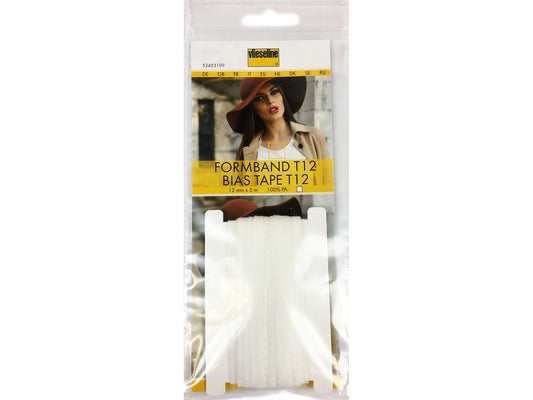-
Prym - Iron-on hem interfacing with backing paper - 20mm, white
Regular price €4,60 EURRegular price -
Vlieseline embroidery set
Regular price €16,90 EURRegular price -
Vlieseline Stretchfix - 30cm x 5m
Regular price €23,90 EURRegular price -
Vlieseline - 272 Thermolam - white
Regular price €3,50 EURRegular price -
Vlieseline Formband T12
Regular price €5,90 EURRegular price -
Vlieseline H200 iron-on interlining - white
Regular price €3,00 EURRegular price
Collection: interfacing
Nonwoven fabric and volume fleece knowledge
What is Vlieseline?
Vlieseline is a brand name from the manufacturer Freudenberg, synonymous with fusible interfacings such as iron-on or sew-in interfacings. These materials, when correctly applied by ironing or sewing, reinforce other materials, such as fabric, giving them shape, volume, and stability. Most often, these fusible interfacings are made of wool or wild silk. Vlieseline products are extremely popular as interfacings among both hobbyists and professional sewers. Their range of applications in sewing is vast. Whether for appliqués, edges, fringes, seams, or loops – Vlieseline is a fantastic tool, especially for patchwork and quilting.
What is the purpose of non-woven fabric by the meter, or volumetric non-woven fabric by the meter?
Beginners in sewing often wonder what interfacing, fusible interfacing, and batting are actually used for. They are mostly used to provide shape and stability or to serve as lining. Therefore, they are primarily suitable for:
- to retain heat in the garment as a lining material
- to facilitate creative application and design tasks
- to give the sewing project structure and volume
- to protect small parts, such as buttons, from being torn off or pulled out.
- to reinforce excerpts or evidence
- for reinforcing the waistband and button placket
The various Vlieseline products cover different areas and fulfill different functions. There are fusible interfacings that you can iron on and interfacings that need to be sewn in. Vlieseline products are not only suitable for giving light and thin fabrics more stability, volume, or body, but they can also be used for creative purposes. For example, you can create fantastic looks with the help of fusible interfacings. With Framilastic, you can create beautiful, playful gathers on sleeves or necklines. Vliesofix is double-sided adhesive and therefore perfect for applying appliqués for decoration, embellishment, and individual design. As a volume fleece, it is wonderfully suited for lining jackets, quilts, or patchwork blankets. In addition to decorative applications, stability is, of course, a frequently desired factor. Vlieseline is well-suited for reinforcing bags, backpacks, and even shirt collars.
What types of Vlieseline fixing inserts and volume tiles are available?
What are the benefits of non-woven fabric inserts?
Fabric interlinings consist of a dense woven structure, resulting in high stability. G700 to G785 is primarily used to provide stability and shape to garments without the need for a lining. Visually, fabric interlinings differ from non-woven interlinings, which have loosely connected fibers, due to their visibly interwoven threads.
What are Vlieseline fleece inserts?
Unlike woven interfacings, which are made from a woven structure, non-woven interfacings consist of loose fibers bonded together. Depending on their construction, non-woven interfacings can be thinner, firmer, or more voluminous. They are primarily used for small items such as reinforcing facings and collars. Popular in this category are H200 and H180, which are very well suited for fine, lightweight fabrics.
What is volume fleece used for?
As the name suggests, batting is used to create volume, shape, and stability. It's suitable for sewing projects such as patchwork quilts, bags, cases, and more. Batting like H630 and H640 can provide better structure in these projects. Batting like H280 is also ideal as a lining for warm clothing during the colder months.
The highly durable 272 Thermolam, which conducts heat very poorly and therefore provides excellent heat insulation, can be used, for example, for runners, wall hangings, and tablecloths. It is also very well suited for pot holders or as a protective ironing mat for embroidery or similar projects.
What is the application area of fusible interfacings from the Vlieseline creative range?
Even for creative design projects like appliqué work, the right fusible interfacing can be very useful. Vliesofix, for example, is one such material. This double-sided fusible interfacing is simply ironed onto the back of the appliqué design by pressing it down. Then, the image to be appliquéd can simply be cut out. Next, the backing paper on the reverse side needs to be removed, and you can align and press the appliqué onto the fabric. Now nothing can slip, and you can easily sew the reinforced appliqué on.
Stylevil is also very popular with DIY enthusiasts. It's a reliable helper when it comes to padding and protecting valuables inside bags, cases, and pouches. However, it not only offers storage advantages but is also suitable for shaping and providing stability.
What purpose do non-woven tapes serve?
When you think of interfacing tapes from Vlieseline manufacturer Freudenberg, Bundfix, Framilastic, and Formband immediately come to mind. Bundfix, with its pre-cut lines, is ideal for quickly and easily creating waistbands for skirts and trousers without any drawing or marking. When sewing, you simply follow the guidelines. Bundfix also ensures the waistband retains its shape permanently. Framilastic is used to maintain the shape of elastic seams. It is primarily used for gathering and ruching. The iron-on Formband is a diagonally cut tape used to secure angled and curved edges, such as those found on necklines and sleeves.





